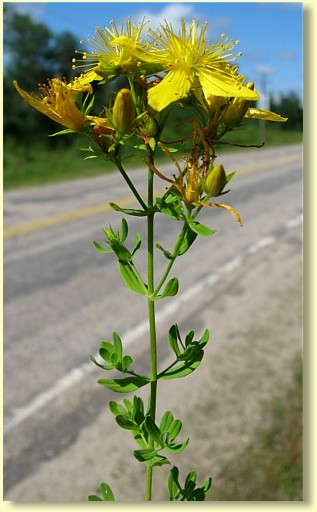
(editor's note: Many of my posts include powerful plants like St. John's Wort. Why not plant your own? Today I'll give you some tips on growing and harvesting this fascinating plant.
In time, the science of light and sound will advance so that we can update our medical centers, similar to those used on our Healing Ships.
Awakening within us all is the ability to completely heal ourselves.
As our bodies evolve from carbon-based to a crystalline-based structure, we must all learn how to properly nourish and treat our physical body.
Through this "Natural Remedies" segment I hope to introduce you to methods of healing you may not have tried, as well as building your knowledge base so you can help others.
I have now archived my articles on Facebook: https://www.facebook.com/NaturalRemediesCollection?skip_nax_wizard=true#
~Be well, all my Love, Boo)
St. John's Wort (Hypericum perforatum)
As you can probably guess from it's Latin name, the St. John's Wort plant has the appearance of perforated leaves when they're held up to the light. It's characterized by tiny yellow flowers and slender oval leaves, and grows to 2-3 feet in height. One way to identify the plant is to pinch the leaves or flowers which will turn red because of the release of its medicinal component -hypericin. This red pigment was said to represent the blood of St. John the Baptist, the plants' namesake.
Note: There is an ornamental version of Hypericum that does not contain any healing properties. Only Hypericum perforatum does, so you may need to look for St. John's Wort in specialty or mail-order nurseries. You can always find a clump in the wild and gather just a thimble-full of seeds. Never dig up native plants because it could harm the balance of the natural habitat.
Native to the U.S. and Europe, St. John's Wort will continue to return year after year and can be seen beside country paths and on the sunny edges of woodlands. The hypericin is thought to be responsible for it's known antidepressant, antibiotic, antiviral and wound healing capabilities. The herb is being studied as a possible treatment for AIDS, the herpes virus and mononucleosis.

Growing
St. John's Wort loves sunny, warm locations but will grow in partial shade. It likes well-drained soil with a high humus content. Between March and May, sow the seeds thinly in a small box or a seeding tray filled with potting soil. Cover the seeds with a thin layer of soil. Mist them thoroughly with water and keep them moist. The seeds will germinate in approximately 14-20 days. After the seedlings have grown to about 1-2 inches, transplant them in clusters of 3 into small pots filled with a growing medium. Place the pots in a sunny location and make sure they get enough water (they don't like standing in water or becoming dry.)
Harvesting
Though you can harvest from June to August, the fresh plant contains the highest active ingredients at the end of June. This is why it is traditionally harvested near the time of the Summer Solstice.
For tea, gather the upper nonwoody parts and hang them in a dark place with the flower heads down. Use only the flowers to make herb oil (which is great for skin problems, bruises and joint ailments.)
In the fall, simply cut back the stems to just above ground level. Set the plants out in your garden about 12 inches apart. Cover the base with a light mulch after the first frost, and they will bloom again the next summer.
The easiest way to propagate St. Joh's Wort is by dividing the plants in the spring or fall. Dig up your plants and divide the root tufts into several portions. Replant in well worked, enriched soil. Collect some seeds from existing plants in the fall and store them in a dry, dark place during the winter to sow in the spring or share with a friend!

